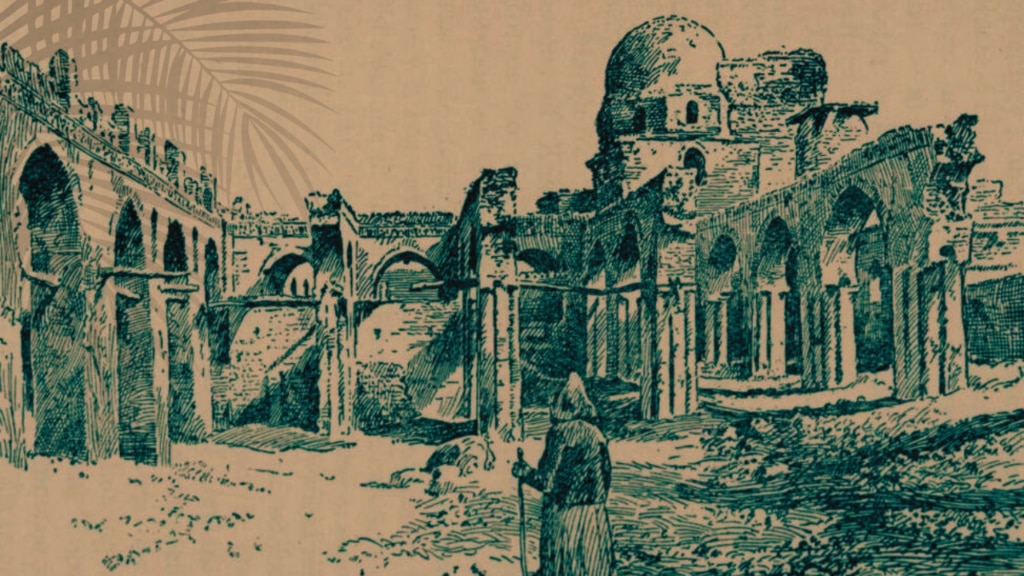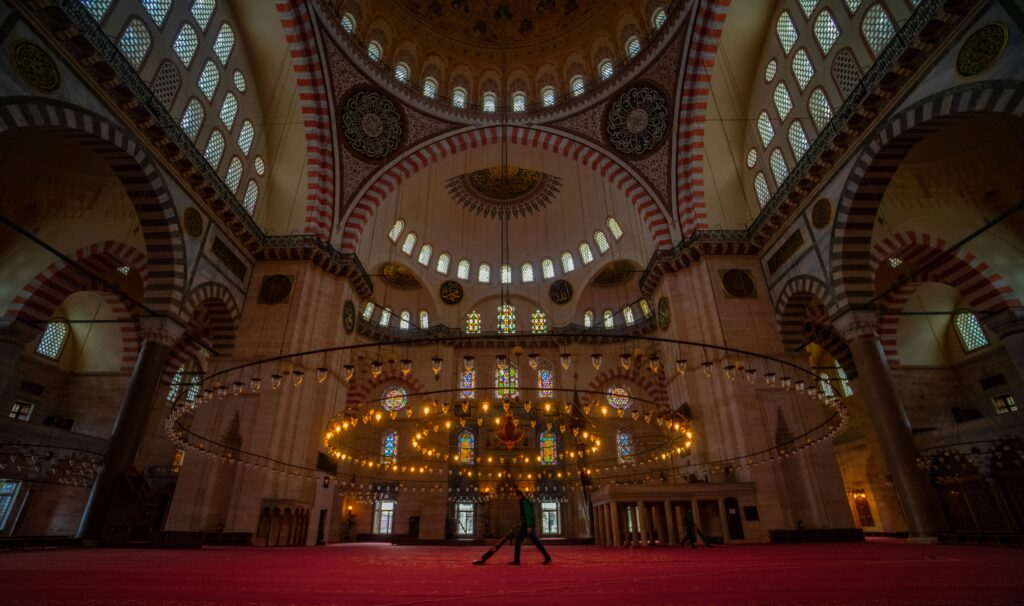Kashifa Mehak Idrees, BA in the study of Religion & Politics, UK

The phrase “our rooms are a reflection of our minds” is something that is commonly championed by masters of feng shui and minimalism in a noble attempt to get us to reevaluate the environment that we inhabit. It is undeniable that our surroundings have an impact on our mental well-being and ability to function. To put it candidly: messy room, messy mind and while I’m sure none of us are strangers to lazily kicking things under the bed or pretending we don’t see the piles of clothes we leap over to get across the room, in one way or another, we all endeavour to create spaces in which we are able to thrive.
In the realm of spirituality, mosques are transformed from their material formation of bricks and plaster into hubs of religiosity in which a believer is able to orient their attention towards worship. In this manner, our mosques become physical manifestations of the essence of spiritual growth that we hope to achieve through our prayers.
The beauty of Islamic architecture has been captured by eager Instagrammers globally, with tourists contorting in any position necessary to get that perfect picture in which the mosque gleams against the sunlight or bathes under the stars; however, structural beauty is not the only achievement of a mosque’s architecture.
Many architectural devices are at play in a mosque which are unflagging in their efforts to promote the maximum amount of religious devotion and attention to that larger task at hand (not a perfect Instagram picture) but of course, prayers.
Themes in Islamic architecture
1. Tawhid
The oneness of Allah (tawhid) is a core tenet in Islamic architecture. All aspects of stylistic choices are bound by the singular aim of promoting the ubiquitous power and awe of Allah throughout the mosque. The dome, geometric patterns, and use of symmetry are all devices used to centre God in a believer’s mind and focusing our attention on prayer.
Unlike other mediums of art, which promote storytelling through the artist’s personal creativity coming to life, mosque artistry aims to promote the infinite and boundless nature of God. This can be seen in the notable absence of figurative art in mosques as no images of animate beings will appear in any place of Islamic worship. Instead, the use of geometric shapes and arabesque designs offer little distraction to the worshipper, who is then allowed to concentrate on the duty of worship.

2. Detachment
Balancing the scales of deen (religion) and dunya (the world/material) is an inherent feature of every believer’s personal religiosity. Upon entering the mosque, we consciously prepare ourselves for the prayer/sermon that we are about to engage in both physically (ablution, taking our shoes off, lowering our voices, dressing modesty) and mentally (preparing ourselves for prayer, focusing our mind on devotion, etc).
The use of Arabic calligraphy of Quranic verses which appears in various parts of mosques are constant reminders of the words of Allah Almighty. Phrases such as “La ghaliba illallah” (There is no conqueror but Allah) which is etched into the walls of Alhambra Mosque in Granada, Spain work to promote Allah’s Omnipotence in every angle of the mosque.
The Sultan Ahmed Mosque in Istanbul is a unique example of Islamic architecture with its use of 20,000 hand-painted blue Iznik tiles that draw a worshipper’s eyes heavenward, reinforcing the spiritual connection between the earthly and the divine.
The unique use of light and colour through arches and columns such as in the Great Mosque of Cordoba, Spain, all generate an innovative illusion of vast space and optimise the feeling of serenity within a mosque. The lack of harsh colours/imagery are all tools used to offer respite from material and worldly possessions and instead allow the mosque to be a space of humility that promotes an internal spiritual equilibrium.
3. Equality
The mosque is a space that transcends hierarchical boundaries of race, class, or social standing and instead offers a union for all worshippers. Standing side-by-side in prayer, the sense of brotherhood and comradeship is palpable and stands as an example of the ethos of equality in Islam.
An architectural feature that aids in promoting this is the orientation of the mosque which is positioned towards the Ka‘bah (Qibla) meaning that each and every Muslim is united in prayers as they pray towards the same sacred location. There is no concept of “reserved” or “special” seating in mosques as all worshippers follow the same routine sequence of prayers under one singular Imam’s leadership.
Art as a form of devotion
Art and religion are no strangers to one another and their relationship has conceived some of the greatest patrons of art. Their masterpieces are renowned motifs that are ubiquitous in the cultural imagination and are revered by thousands. From Michelangelo’s “Hand of God” to Davinci’s “Last Supper”, religious imagery is scattered all over the domain of art and stems from a core intention of devotion.
Despite stylistic differences between mosque and church architecture that we have previously touched upon, it is clear that the two institutions are united in their efforts to create a space where religion can flourish.
Breaking away from static conceptions of devotion that only focus on scriptural and learned religiosity, it is important to note that even the space in which we worship has intention behind it. Each meticulous decision that is made, from the structure of the minarets to the colours of the walls, are a culmination of choices that capture the feeling of prayer.
It is no surprise that upon arrival, we feel a sense of calm and ease as we prepare ourselves physically via ablution and adhering to the etiquette of the mosque and are ready to commit to our prayer. The serene silence and cleanliness of the mosque all work to catalyse the spirituality of our prayer. All these features are subliminal testaments to the ingenuity of mosque architecture and shine a light on just one aspect of the beauty of Islamic devotion and how it seeps into divergent aspects of our lives.
The next time you step into a mosque, take notice of these features and assess how they help your prayer. In our own homes, we should try to mimic this by creating clean and calm spaces for worship, so if you’re looking for an excuse to get someone in your household to clean up, you’ve found one: Salat.

Destruction of physical sacrality
Having explored just how awe-inspiring the mosque is and how its very composition works to promote our connection with Allah, we can understand just how violent the act of destroying one is.
In his Friday Sermon on 17 January 2024, Hazrat Khalifatul Masih Vaa spoke on the destruction of an Ahmadi mosque in Daska, Pakistan, which had likely been built by Hazrat Sir Zafrulla Khanra, an advocate for peace and justice. As local administration and policing staff orchestrated a 4-hour-long demolition, it was not just bricks and mortar that their bulldozers aimed to destroy, but a space of sacred sanctuary. Not only had this building stood as a cultural remnant of pre-partition sub-continent, but just like every other mosque across the globe, this had been built in the Glory of Allah and for the purpose of worship and gratitude.
It is a grotesque act of malice to destroy such serene structures and even more abhorrent to do so while claiming to act in the service of Allah. Thankfully, much to the dismay of malicious persecutors who are at the height of their hubris, our divine spirituality and love for Allah can never be bulldozed and will always remain intact.

For many of us living in other parts of the world, such instances should remind us what an honour and privilege it is to be able to visit our local mosques without fear of persecution, and render thanks to Allah. It is one that we should hold dear and near as we marvel at Allah’s creation and step into a hub of tranquillity and piety.
It is no wonder that the Holy Prophetsa is reported to have said:
“The parts of land dearest to Allah are its mosques […]” (Sahih Muslim, Hadith 671)

